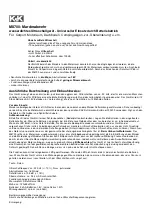
Service Manual
Appendix B EMC Guidance and Manufacturer’s Declarations
81
Table 17. Electromagnetic Immunity
The electrocardiograph is intended for use in the electromagnetic environment specified below. The customer or user of the electrocardiograph
should assure that it is used in such an environment.
Immunity Test
IEC 60601
Test Level
Compliance
Level
Electromagnetic Environment - Guidance
Portable and mobile RF communications equipment should be used no closer
to any part of the electrocardiograph, including cables, than the
recommended separation distance calculated from the equation applicable
to the frequency of the transmitter.
Recommended separation distance
Conducted RF
IEC 61000-4-6
3 Vrms
150 kHz to 80 MHz
3 Vrms
d
= (1.17)
Radiated RF
IEC 61000-4-3
3 V/m
80 MHz to 2.5 GHz
3 V/m
d
= (1.17)
80 MHz to 800 MHz
d
= (2.33)
800 MHz to 2.5 GHz
where
P
is the maximum output power rating of the transmitter in watts (W)
according to the transmitter manufacturer and
d
is the recommended
separation distance in metres (m).
Field strengths from fixed RF transmitters, as determined by an
electromagnetic site survey,
a
should be less than the compliance level in
each frequency range.
b
Interference may occur in the vicinity of equipment marked with the
following symbol:
Note 1: At 80 MHz and 800 MHz, the higher frequency range applies.
Note 2: These guidelines may not apply in all situations. Electromagnetic propagation is affected by absorption and reflection from structures,
objects, and people.
a
Field strengths from fixed transmitters, such as base stations for radio (cellular/cordless) telephones and land mobile radios, amateur radio,
AM and FM radio broadcast and TV broadcast cannot be predicted theoretically with accuracy. To assess the electromagnetic environment due
to fixed RF transmitters, an electromagnetic site survey should be considered. If the measured field strength in the location in which the
electrocardiograph is used exceeds the applicable RF compliance level above, the electrocardiograph should be observed to verify normal
operation. If abnormal performance is observed, additional measures may be necessary, such as reorienting or relocating the
electrocardiograph.
b
Over the frequency range 150 kHz to 80 MHz, field strengths should be less than 3 V/m.
P
P
P
Summary of Contents for CP 100
Page 6: ...vi Contents Welch Allyn CP 100 and CP 200 Electrocardiograph ...
Page 7: ...1 1 Safety Summary Introduction 2 Symbols 2 Servicing the Electrocardiograph Safely 4 ...
Page 34: ...28 Overview Welch Allyn CP 100 and CP 200 Electrocardiograph ...
Page 47: ...4 41 Troubleshooting Problem Solving Suggestions 42 Limited Warranty 45 Service Policy 46 ...
Page 82: ...76 Field Replaceable Parts Welch Allyn CP 100 and CP 200 Electrocardiograph ...
Page 90: ...84 Appendix C Software Updates Welch Allyn CP 100 and CP 200 Electrocardiograph ...
Page 91: ...D 85 Interconnect Diagrams CP 200 Interconnect Diagram 86 CP 100 Interconnect Diagram 87 ...
Page 93: ...Service Manual Appendix D Interconnect Diagrams 87 CP 100 Interconnect Diagram ...
Page 94: ...88 Appendix D Interconnect Diagrams Welch Allyn CP 100 and CP 200 Electrocardiograph ...
Page 95: ......










































